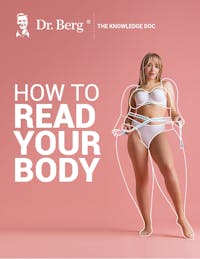Vitamin K2 Benefits for Hair

How to Read Your Body
Learn to recognize common symptoms and uncover their underlying health issues
Understand the signs of nutrient deficiencies to manage your health
Explore the four metabolic body types and the core factors that influence them
Interpret your body's signals from head to toe to identify potential health concerns

How to Read Your Body
Learn to recognize common symptoms and uncover their underlying health issues
Understand the signs of nutrient deficiencies to manage your health
Explore the four metabolic body types and the core factors that influence them
Interpret your body's signals from head to toe to identify potential health concerns

How to Read Your Body
Learn to recognize common symptoms and uncover their underlying health issues
Understand the signs of nutrient deficiencies to manage your health
Explore the four metabolic body types and the core factors that influence them
Interpret your body's signals from head to toe to identify potential health concerns

How to Read Your Body
Learn to recognize common symptoms and uncover their underlying health issues
Understand the signs of nutrient deficiencies to manage your health
Explore the four metabolic body types and the core factors that influence them
Interpret your body's signals from head to toe to identify potential health concerns

How to Read Your Body
Learn to recognize common symptoms and uncover their underlying health issues
Understand the signs of nutrient deficiencies to manage your health
Explore the four metabolic body types and the core factors that influence them
Interpret your body's signals from head to toe to identify potential health concerns

How to Read Your Body
Learn to recognize common symptoms and uncover their underlying health issues
Understand the signs of nutrient deficiencies to manage your health
Explore the four metabolic body types and the core factors that influence them
Interpret your body's signals from head to toe to identify potential health concerns

How to Read Your Body
Learn to recognize common symptoms and uncover their underlying health issues
Understand the signs of nutrient deficiencies to manage your health
Explore the four metabolic body types and the core factors that influence them
Interpret your body's signals from head to toe to identify potential health concerns

How to Read Your Body
Learn to recognize common symptoms and uncover their underlying health issues
Understand the signs of nutrient deficiencies to manage your health
Explore the four metabolic body types and the core factors that influence them
Interpret your body's signals from head to toe to identify potential health concerns

How to Read Your Body
Learn to recognize common symptoms and uncover their underlying health issues
Understand the signs of nutrient deficiencies to manage your health
Explore the four metabolic body types and the core factors that influence them
Interpret your body's signals from head to toe to identify potential health concerns

How to Read Your Body
Learn to recognize common symptoms and uncover their underlying health issues
Understand the signs of nutrient deficiencies to manage your health
Explore the four metabolic body types and the core factors that influence them
Interpret your body's signals from head to toe to identify potential health concerns

How to Read Your Body
Learn to recognize common symptoms and uncover their underlying health issues
Understand the signs of nutrient deficiencies to manage your health
Explore the four metabolic body types and the core factors that influence them
Interpret your body's signals from head to toe to identify potential health concerns

How to Read Your Body
Learn to recognize common symptoms and uncover their underlying health issues
Understand the signs of nutrient deficiencies to manage your health
Explore the four metabolic body types and the core factors that influence them
Interpret your body's signals from head to toe to identify potential health concerns

How to Read Your Body
Learn to recognize common symptoms and uncover their underlying health issues
Understand the signs of nutrient deficiencies to manage your health
Explore the four metabolic body types and the core factors that influence them
Interpret your body's signals from head to toe to identify potential health concerns

How to Read Your Body
Learn to recognize common symptoms and uncover their underlying health issues
Understand the signs of nutrient deficiencies to manage your health
Explore the four metabolic body types and the core factors that influence them
Interpret your body's signals from head to toe to identify potential health concerns

How to Read Your Body
Learn to recognize common symptoms and uncover their underlying health issues
Understand the signs of nutrient deficiencies to manage your health
Explore the four metabolic body types and the core factors that influence them
Interpret your body's signals from head to toe to identify potential health concerns

How to Read Your Body
Learn to recognize common symptoms and uncover their underlying health issues
Understand the signs of nutrient deficiencies to manage your health
Explore the four metabolic body types and the core factors that influence them
Interpret your body's signals from head to toe to identify potential health concerns

How to Read Your Body
Learn to recognize common symptoms and uncover their underlying health issues
Understand the signs of nutrient deficiencies to manage your health
Explore the four metabolic body types and the core factors that influence them
Interpret your body's signals from head to toe to identify potential health concerns

How to Read Your Body
Learn to recognize common symptoms and uncover their underlying health issues
Understand the signs of nutrient deficiencies to manage your health
Explore the four metabolic body types and the core factors that influence them
Interpret your body's signals from head to toe to identify potential health concerns

How to Read Your Body
Learn to recognize common symptoms and uncover their underlying health issues
Understand the signs of nutrient deficiencies to manage your health
Explore the four metabolic body types and the core factors that influence them
Interpret your body's signals from head to toe to identify potential health concerns

How to Read Your Body
Learn to recognize common symptoms and uncover their underlying health issues
Understand the signs of nutrient deficiencies to manage your health
Explore the four metabolic body types and the core factors that influence them
Interpret your body's signals from head to toe to identify potential health concerns

How to Read Your Body
Learn to recognize common symptoms and uncover their underlying health issues
Understand the signs of nutrient deficiencies to manage your health
Explore the four metabolic body types and the core factors that influence them
Interpret your body's signals from head to toe to identify potential health concerns

How to Read Your Body
Learn to recognize common symptoms and uncover their underlying health issues
Understand the signs of nutrient deficiencies to manage your health
Explore the four metabolic body types and the core factors that influence them
Interpret your body's signals from head to toe to identify potential health concerns

How to Read Your Body
Learn to recognize common symptoms and uncover their underlying health issues
Understand the signs of nutrient deficiencies to manage your health
Explore the four metabolic body types and the core factors that influence them
Interpret your body's signals from head to toe to identify potential health concerns
Vitamin K is a fat-soluble vitamin that regulates calcium balance and may prevent scalp calcification, a leading cause of hair-related issues, including brittle hair and hair shedding.
Discover how vitamin K2 benefits hair growth and why taking vitamin K2 with vitamin D3 may help prevent hair loss.

What is vitamin K?
Vitamin K is a fat-soluble vitamin that occurs in two primary forms: vitamin K1 and vitamin K2.
Both vitamins K1 and K2 regulate the production and activation of proteins involved in blood clotting, essential for effective wound healing and preventing excessive bleeding.
In addition to its role in blood clotting, vitamin K2 redirects circulating calcium into the bones, which promotes bone health and lowers the risk of calcium deposits in blood vessels and other soft tissues such as tendons, joints, and the scalp.
Maintaining adequate levels of vitamin K2 is linked to a lower risk of arterial calcification, a primary risk factor for atherosclerosis, heart disease, and stroke.
Watch the video below to discover the top seven essential nutrients for hair growth.
Vitamin K2 benefits for hair
Vitamin K2 regulates the activity of matrix Gla protein (MGPs), a type of protein that binds to calcium in the blood and facilitates its transport and deposition into bone and teeth.
Maintaining balanced levels of circulating calcium is crucial for health and essential to lowering the risk of calcium accumulation in soft tissues such as the scalp.
Scalp calcification is characterized by a buildup of calcium beneath the skin, which can reduce blood circulation and nutrient exchange and may cause impaired function of hair follicles, a common cause of hair loss.
It’s thought that vitamin K2 helps promote hair growth by regulating blood calcium levels and preventing scalp calcification.
Vitamin K2 works in synergy with other vitamins, and its role in calcium metabolism is closely linked to optimal vitamin D levels.
Interestingly, vitamin D has also been found to support hair growth, as it actively stimulates hair follicle proliferation and regeneration.
A study published in Endocrinology found that vitamin D3 regulates the growth and renewal of keratinocytes, the predominant cell type from which hair follicles develop.

Natural sources of vitamin K2
Some top vitamin K2 foods include egg yolks, butter, dairy products, organ meats, oily fish and fermented foods such as kimchi, sauerkraut, natto and kefir.
In addition, vitamin K2 is the only fat-soluble vitamin that can be produced by certain bacteria in the human gut, and increasing a diverse intestinal microflora with probiotic foods may play an essential role in supporting a healthy vitamin K2 status.
Fermented foods are almost always a rich source of vitamin K2 and probiotics. A study published in The International Journal of Applied Pharmaceutics found that regularly consuming fermented vegetables and dairy products is linked to a lower risk of hair loss and other signs of aging.

When should you take vitamin K2?
The human body stores only small amounts of vitamin K, which can be rapidly depleted without adequate dietary intake, and research published in StatPearls estimates that up to 30 percent of adults may have insufficient vitamin K stores.
Vitamin K deficiency can lead to impaired blood clotting, associated with easy bruising, bleeding gums, nosebleeds, or heavy menstrual bleeding.
If you show signs of vitamin K deficiency, it’s crucial to consult a healthcare provider to evaluate your vitamin K blood levels and discuss the benefits of vitamin K2 supplementation.
Vitamin K supplements offer an effective and safe strategy to promote healthy vitamin K levels and should be considered for individuals at increased risk of deficiency, such as people with poor liver function, cirrhosis, or fatty liver disease.
In addition, those with malabsorption issues due to Crohn’s disease or gallbladder problems may benefit from taking vitamin K supplements due to impaired ability to absorb dietary vitamin K2.

Optimal vitamin K2 dosage for hair growth
While more research is needed to establish the optimal vitamin K2 dosage for hair growth, most healthcare providers suggest a daily vitamin K intake of 120 mcg for men and 90 mcg for women.
However, if you want to maximize the benefits of vitamin K2 and D3 for hair health, it’s best to take a combined vitamin K2 and D3 supplement.
Significant advances have been made in uncovering the best ratio of vitamin D3 to K2 for optimal health, and it’s recommended to choose a vitamin K2 and D3 product that contains at least 10 mcg of vitamin K2 for each 1000 IU of vitamin D3.
Vitamin K2 and D3 are fat-soluble and should be taken with a fat-containing meal to enhance intestinal absorption.

Does vitamin K2 interact with any medications?
Vitamin K2 can interact with certain medications, particularly those that affect blood clotting and blood thinning, such as warfarin and medications used to treat deep vein thrombosis.
There also is evidence that certain weight loss drugs and antibiotics can impair vitamin K absorption and increase the risk of deficiency.
If you are taking prescription medications and are considering taking vitamin K2, it’s vital to consult a healthcare provider or pharmacist to discuss the use of vitamin K supplements and the potential for drug interactions.

Key takeaways
Vitamin K2 benefits hair growth by lowering the risk of scalp calcification, which is associated with thin and brittle hair and increases the risk of hair loss.
Combining vitamin K2 with D3 maximizes the potential benefits for hair health, and it’s recommended to choose a balanced vitamin K2 and D3 supplement that contains at least 10 mcg of vitamin K2 for each 1000 IU of vitamin D3.
Additional vitamin K2 resources
FAQ
1. Does vitamin K help your hair?
Vitamin K helps maintain the body’s calcium balance and lowers the risk of calcium deposition in soft tissues such as blood vessels and the scalp.
Scalp calcification can lead to a reduced flow of oxygen and nutrients to hair follicles, leading to thin and brittle hair and hair loss.
2. How does vitamin K2 affect your hair?
Lack of adequate vitamin K2 can lead to the accumulation of calcium in scalp tissue, which can negatively impact the health of hair follicles.
Hair follicles play a crucial role in growing strong and healthy hair, and vitamin K may potentially promote hair follicle health by preventing scalp calcification.
3. What happens when you start taking vitamin K2?
When you start taking vitamin K2, your body starts producing proteins needed for blood clotting and becomes more efficient at redirecting calcium from the blood into bones.
Taking vitamin K2 can improve bone strength and lower the risk of excessive bleeding, osteoporosis, and soft tissue calcification linked to atherosclerosis.
4. Is vitamin D3 with K2 good for hair growth?
Yes, both vitamin K2 and D3 promote healthy hair follicles and hair growth.
Vitamin K helps prevent scalp tissue calcification associated with impaired hair follicle function and hair loss, and vitamin D3 plays a crucial role in regulating the renewal of keratinocytes, a crucial cell type needed to grow hair strands.
5. How much vitamin K2 is ideal for hair growth?
Most healthcare providers recommend a daily vitamin K2 intake of at least 120 mcg for men and 90 mcg for women.
However, if you are taking vitamin D3 supplementation, it’s crucial to adjust your vitamin K2 dosage to a ratio of 10:1000, which means you should take 10 mcg of vitamin K2 per 1000 IU of vitamin D3.
6. What nutrients support hair health?
Several nutrients, including vitamins K2 and D3, zinc, and copper, help maintain hair follicle function and support healthy hair.
In addition, omega-3 fatty acids, vitamin C, and the vitamin B complex are vital for skin and scalp integrity and can help lower the risk of hair loss linked to poor scalp health.
Sources
Next blog
7 Vitamins for Stress and Anxiety ReliefTags

Popular
08/21/2024
40.2K views
05/22/2024
36.8K views
08/19/2024
214.3K views
03/18/2024
11/21/2022




